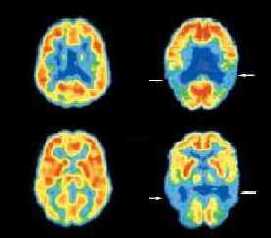Researchers find missing link between amyloid and tau in Alzheimers disease
Feb 8, 2007 - 3:13:37 AM
, Reviewed by: Dr. Ankush Vidyarthi
|
|
|
We think weve found one of the seminal cell biological events in the pathogenesis of Alzheimers and if we can figure out all of the steps in the process and understand each player at every step, it will represent many potential new drug targets for Alzheimers therapy."
|
|
Key Points of this article
|
|
In Alzheimers disease, two kinds of abnormal structures accumulate in the brain: amyloid plaques and neurofibrillary tangles.
|
|
In the study, the researchers found a deadly connection between beta-amyloid and tau, one that occurs before they form plaques and tangles, respectively.
|
|
|
|
By University of Virginia,
[RxPG]
 |
| The paper defines one of the earliest events that causes neurons to die in both early-onset familial Alzheimer%u2019s and late-onset Alzheimer%u2019s disease. This is the first evidence for the long elusive %u2018missing link%u2019 between amyloid and tau in Alzheimer%u2019s disease. |
Scientists at the University of Virginia have identified what appears to be a major missing link in the process that destroys nerve cells in Alzheimers disease, an incurable disease that slowly destroys memory and cognitive abilities. The findings are reported in the Nov. 20, 2006, issue of the Journal of Cell Biology and could eventually lead to new drugs that target and disrupt specific proteins that conspire in the brain to cause Alzheimers.
In Alzheimers disease, two kinds of abnormal structures accumulate in the brain: amyloid plaques and neurofibrillary tangles. The plaques contain fibrils that are made from protein fragments called beta-amyloid peptides. The tangles also are fibrous, but they are made from a different substance, a protein called tau. In the new U.Va. study, the researchers found a deadly connection between beta-amyloid and tau, one that occurs before they form plaques and tangles, respectively.
According to George Bloom, the senior author of the study and a professor of biology and cell biology at U.Va., this connection causes the swiftest, most sensitive and most dramatic toxic effect of beta-amyloid found so far. What makes it most remarkable, though, is that it requires a form of amyloid that represents the building blocks of plaques, so called pre-fibrillar beta-amyloid, and it only happens in cells that contain tau. Even though they account for just ~10 percent of the cells in the brain, nerve cells are the major source of tau, which likely explains why they are specifically attacked in Alzheimers disease.
The researchers used cultured mammalian cells that either did or did not make tau to study how cells respond to beta-amyloid. They found that pre-fibrillar, but not fibrillar beta-amyloid works together with tau to break apart microtubules highways along which synapse replacement parts move rapidly in the nerve cell from where they are made to where they are needed. Synapses are connections between nerve cells, and in the brain they are the structural basis of memory and cognition. When nerve cells in the brain lose their microtubules they also lose the ability to replace worn out synapse parts, and synapses therefore disappear. The loss of synapses, and consequent loss of memories and cognitive skills, cannot be reversed, and can lead directly to nerve cell death.
We think weve found one of the seminal cell biological events in the pathogenesis of Alzheimers and if we can figure out all of the steps in the process and understand each player at every step, it will represent many potential new drug targets for Alzheimers therapy, Bloom said. Our paper defines one of the earliest events that causes neurons to die in both early-onset familial Alzheimers and late-onset Alzheimers disease. We believe this is the first evidence for the long elusive missing link between amyloid and tau in Alzheimers disease.
This is a very significant finding that greatly improves our understanding of the mechanisms within the cell that ultimately lead to Alzheimers disease, said Lester Binder, professor of cell and molecular biology at Northwestern University and a leading researcher on Alzheimers. Binder said he has already incorporated the U.Va. study into classes he teaches on the pathogenesis of Alzheimers disease and dementia.
The studys first author and lead investigator is Michelle King, a U.Va. research assistant professor of biology. Other investigators include Bloom, Ho-Man Kan and Alev Erisir of U.Va., Peter W. Baas of Drexel University and Charles G. Glabe of the University of California at Irvine.
Advertise in this space for $10 per month.
Contact us today.
|
 |
|
Subscribe to Alzheimer's Newsletter
|
|
|
|
About Dr. Ankush Vidyarthi
|
This news story has been reviewed by Dr. Ankush Vidyarthi before its publication on RxPG News website. Dr. Ankush Vidyarthi, MBBS is a senior editor of RxPG News. He is also managing the marketing and public relations for the website. In his capacity as the senior editor, he is responsible for content related to mental health and psychiatry. His areas of special interest are mass-media and psychopathology.
RxPG News is committed to promotion and implementation of Evidence Based Medical Journalism in all channels of mass media including internet.
|
|
Feedback
|
For any corrections of factual information, to contact the editors or to send
any medical news or health news press releases, use
feedback form
|
Top of Page
|



